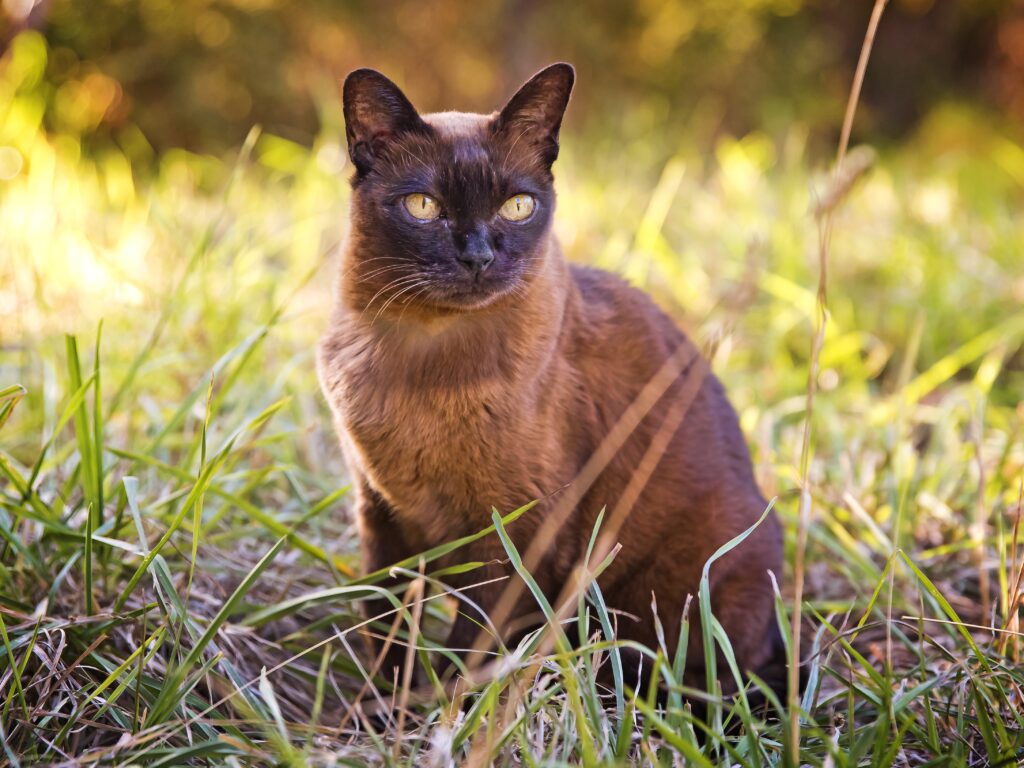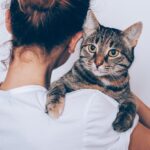The Burmese cat is an attractive and highly popular medium-sized cat which originated from cats on the Thai-Burma border. They are known for their muscular frame, rounded heads, golden yellow eyes and sleek coats in various colours.
Burmese are very popular pedigree cats, almost certainly due to the combination of their attractive features and friendly, social nature.

Description and Characteristics
The Burmese is a medium-sized cat with a substantial bone structure and good muscular development. They are deceptively heavy for their size and have been described as a ‘brick wrapped in silk’! There are currently two breed standards, the British and the American. The former, also known as the traditional, is a more slender version of the Burmese and has a wedge-shaped head, long tapering muzzle and moderately almond-shaped eyes, whereas the latter tends to have a stockier build, with a rounded broad head and a shorter flattened muzzle. The eyes of both types come in a striking range of yellows and golds. The coat of the Burmese is fine and glossy, with a satin-light texture and is short and very close lying. They come in an array of colours, most typically sable (deep brown), champagne (honey beige), blue and platinum.
Burmese cats are very friendly and sociable, often forming a ‘dog-like attachment’ to their owners. They love to play and explore and are particularly bright, thriving on interactive games and playtime with their owners. They can also be trained successfully to retrieve toys. Despite their playful nature, more mature cats may opt for the quiet life, preferring to lounge around; if this is the case, nutrition should be carefully watched to prevent obesity. Owning Burmese cats is seldom quiet! These are vocal cats which don’t hold back in order to gain the attention of their owners. However, their enjoyment of human company makes them a good choice for households looking for a cat with plenty of presence, character and companionship.
Health and common issues
Burmese are generally healthy cats with an average lifespan of 10 to 17 years. However, some lines may be at an increased risk of diabetes mellitus. Hypokalaemic polymyopathy (muscle weakness due to low levels of blood potassium) has been seen in British Burmese cats. With the correct potassium supplement, hypokalemic cats can usually lead a normal life. There is also a DNA test available to identify cats affected by or carrying this recessive gene. There have also been cases of feline orofacial pain syndrome in Burmese cats. This is an acute teething disorder in young kittens where the eruption of the second teeth causes extreme discomfort leading to the cat tearing at its face to try to alleviate the pain.
The Burmese is a medium-sized cat with a substantial bone structure and good muscular development. They are deceptively heavy for their size and have been described as a ‘brick wrapped in silk’! There are currently two breed standards, the British and the American. The former, also known as the traditional, is a more slender version of the Burmese and has a wedge-shaped head, long tapering muzzle and moderately almond-shaped eyes, whereas the latter tends to have a stockier build, with a rounded broad head and a shorter flattened muzzle. The eyes of both types come in a striking range of yellows and golds. The coat of the Burmese is fine and glossy, with a satin-light texture and is short and very close lying. They come in an array of colours, most typically sable (deep brown), champagne (honey beige), blue and platinum.
Burmese cats are very friendly and sociable, often forming a ‘dog-like attachment’ to their owners. They love to play and explore and are particularly bright, thriving on interactive games and playtime with their owners. They can also be trained successfully to retrieve toys. Despite their playful nature, more mature cats may opt for the quiet life, preferring to lounge around; if this is the case, nutrition should be carefully watched to prevent obesity. Owning Burmese cats is seldom quiet! These are vocal cats which don’t hold back in order to gain the attention of their owners. However, their enjoyment of human company makes them a good choice for households looking for a cat with plenty of presence, character and companionship.






